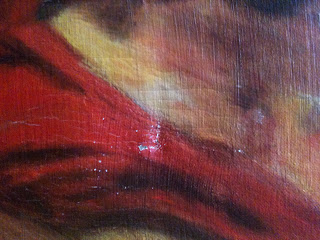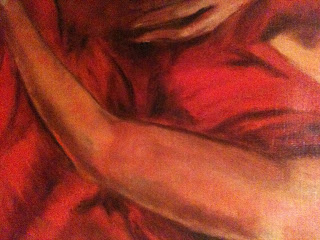This is an image of an oil painting that I was asked to repair. It's an old palette knife and brush combo painting. I'd say just by colors, subject matter and handling it was probably done in the late 70's to early 80's. The painting was damaged by: humidity, change in temperature and poor storing. There was a large indentation that was made by something heavy leaning up against the surface of the painting. It chipped the paint and left a noticeable dimple. The problem was resolved by spraying the back with water to reactivate the sizing in the gesso. The painting tightened up but water reactivation can only work so far. I'd say if the client wanted an absolutely flat surface, then the painting should be carefully taken off of it's stretcher and it should be re-stretched over a PH balanced and prepared solid surface. Ex: A 3/4 thick piece of hardwood that is treated on all sides with gesso. This should be a wood like oak that is sturdy and will not warp easily. The pressure of the wood resting on the backside of the painting will force the painting to flatten out. Another note: This painting was done on linen. Much like linen clothes that always look wrinkled even right after you iron them, linen is so temperamental and affected by change in temperature and moisture. Linen will have more of a tendency to crack over time because it is so easily "influenced". Another note: Palette knife painting on linen in oil is really not the best decision. This is why: The action of applying paint on canvas with a palette knife pushes down on the surface of the canvas. Brushes do this too but brushes do not have a sharp, hard edges that actually scratch the surface of the painting as one applies the paint. The scratching disturbs the paint that was previously applied (the first layer that is thinned with turpentine) to the canvas potentially disturbing the fat over lean ratio. The fat over lean principle cannot be messed with. This is why most of the crackle damage happened in the first place, regardless of accidents, weather, poor storing...etc. Fat over lean has to do with the varying drying times in oil pigments. Each pigment has a specific drying time. This painting was done with earth tones and cadmiums. (Yikes!!) Earth tones generally have very short drying times. Cadmiums have very slow drying times, unless they are cheap paints that have drying mediums added to them. This is the reason why painters are taught to sketch out the first layers with small amounts of earth toned paint and a lot of turpentine. You have to slowly build up from thin layers of earth tones to thicker layers of paint. If you take a palette knife full of an earth color like umber and slap it down on the surface of a gessoed canvas and paint over that in thin layers of paint, you are going to be in crackleland for sure. If you put down a cadmium first and an umber on top of that, you or one of your relatives might be crying at a art restorer's office in a few years. If you are a painter you have to know that when you paint in oil: begin with earth tones in thin layers and build up to thicker layers of paint.

Thick paint applied with a palette knife and damage from an outside source.
Dimple and paint surface damage.
Damage from an outside source.
More scratch damage.
Fat over lean problem.
Restored painting:
All better!!! I used heavy, high pigmented paints with no medium and no turpentine to cover the crackles: Thus, respecting the fat over lean principle. ; )










No comments:
Post a Comment